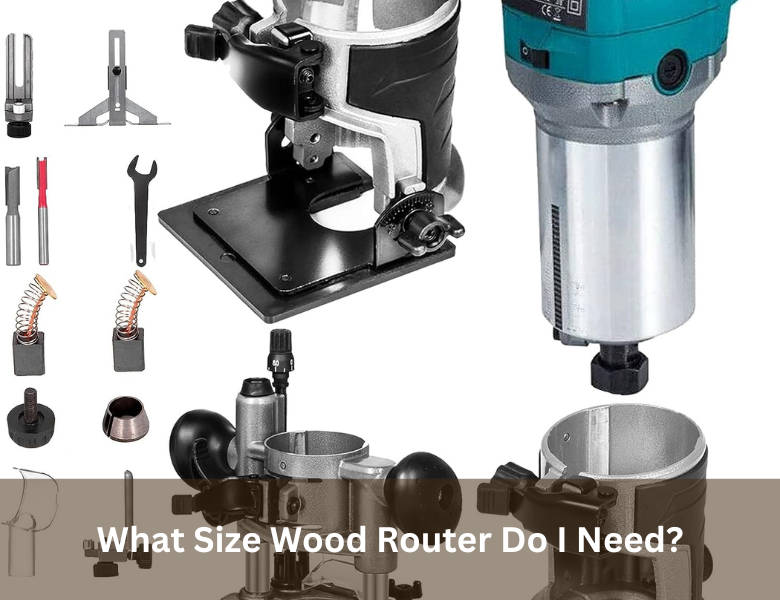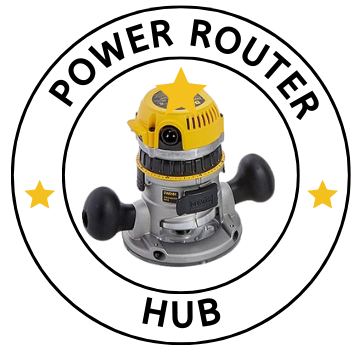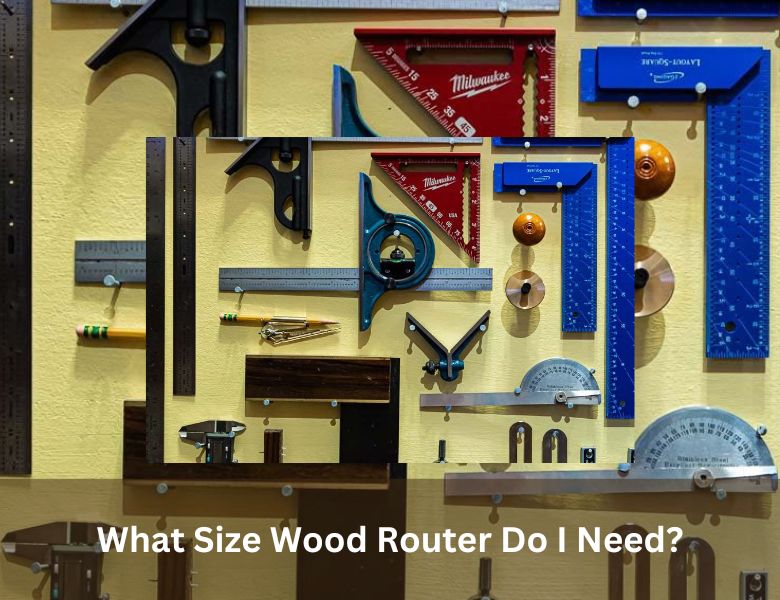For a wood router, the size you need depends on the type of project you are doing. Generally, a mid-range router of around 2-2.25 horsepower with an ¼ inch or ½ inch collet is suitable for most projects including cabinetry, joinery, and trimming.
However, if you plan to take on more heavy-duty projects with larger bits or require more power, a large router of around 3-3. 25 horsepower or a plunge router may be necessary. Conversely, if you only plan on doing light-duty hobby projects, a smaller router with less power may suffice.

Ultimately, the size of the wood router you need is determined by your project requirements and desired level of precision.
Choosing The Right Size Wood Router For Your Project
When it comes to woodworking, a wood router is a versatile tool that you cannot overlook. It turns out that whether you are a professional carpenter or a DIY woodworking enthusiast, investing in a router can be a sound decision. But the confusion arises when you ask, what size wood router do I need?
Well, worry no more because we got you covered. In this blog post, we will provide you with detailed information to help you choose the right size wood router for your project, no matter what level of expertise you have.
Factors To Consider While Choosing A Wood Router Size
Choosing the right router size is essential for the success of your woodworking project. To narrow down your options, here are some factors you should consider:
- Project size and difficulty: Before buying a wood router, it’s essential to consider the size and complexity of your project. For small projects, a compact and lightweight router will suffice, while larger projects require a powerful and robust router.
- The required degree of accuracy: The desired level of accuracy is a vital factor that can dictate the type of wood router you need. If your project requires intricate designs and details, the router size you choose will significantly affect your outcome.
- Preference for ease of use: Choosing a router that is easy and convenient to use is crucial. Based on your experience, you can choose between a simple fixed router or a plunge router with more versatile features.
- Budget: The amount of money you are willing to spend is an important factor to consider when selecting a wood router size. Choosing high-end models may come at an extra cost, but they are durable and may have more features.
Comparison Between Different Wood Router Sizes
Wood routers come in various sizes, which means you have plenty of options, each with its unique feature. Here is a comparison between different router sizes to help you make a wise decision:
- Compact routers: These are smaller and lighter routers designed for small projects such as trimming and cutting edges. They are also an excellent choice for woodworking beginners because they are less expensive and easy to use.
- Mid-sized routers: These routers can handle more significant projects and have more power to cut deeper in hardwoods. They are also versatile and can make different cuts, including grooves and decorative designs.
- Large routers: These routers come with powerful motors and are designed for heavy-duty woodworking projects at a professional level. They can handle deep cuts and have the capability to cut through hardwoods.
Discussion On The Most Common Wood Router Sizes
The most common wood router sizes in the market today are the 2. 25hp, 1. 75hp, and 1. 25hp routers. Here is a brief discussion of each:
- 2.25hp routers: These routers are the most powerful and robust, making them ideal for large scale and heavy-duty projects. They can efficiently handle plunging and can cut through dense materials.
- 1.75hp routers: These routers have sufficient power to handle most projects, including medium-to-large-scale projects. They are less expensive and therefore a more budget-friendly option.
- 1.25hp routers: These are smaller and less powerful routers and are ideal for small diy projects that don’t require too much power. They are more compact and also less expensive.
Choosing the right size wood router for your project is crucial, and you must consider several factors to make an informed decision. It is essential to take into account your project’s size and complexity, the router’s accuracy, ease of use, and budget.
With this information in mind, you will be able to select the perfect router for your woodworking needs and bring your project to life.
Exploring Different Types Of Wood Routers
Overview Of The Different Types Of Wood Routers Available In The Market
Wood routers are excellent tools for woodworking enthusiasts, and they come in various types. They allow you to create intricate designs, angles, and curves with ease. Here are the most common types of wood routers available in the market:
- Fixed-base routers
- Plunge routers
- Combo routers
Discussion On The Features And Functionalities Of Each Type Of Wood Router
Each type of wood router has unique features and functionalities that make it useful for specific projects. Here is a brief look at each type:
Fixed-base routers:
- Best for edge and groove work
- Can be used with a router table
- The base is fixed, which makes it easy to control
Plunge routers:
- Ideal for creating decoration on wood surfaces
- The bit can move up and down, allowing easy cuts into the material
- Can be used for mortising and inlay works
Combo routers:
- Come in both fixed and plunge base configurations
- Versatile, as they can be used for a wide range of projects
- Suitable for projects that need both plunge and fixed-based routing
Importance Of Selecting The Right Type Of Wood Router Based On Project Requirements
Choosing the right type of wood router is critical to achieving success with your woodworking projects. Before selecting a router, consider the following project requirements:
- The type of cuts you want to make
- The size and thickness of the wood
- The intricacy and details of the project
- Your level of comfort and experience with wood routers
Selecting the right type of wood router for your project can lead to precise cuts, smooth finishes, and a final product that exceeds your expectations. Remember to take your time, do your research, and invest in a quality router that fits your project needs.
Mastering Wood Router Techniques For Better Results
If you’re new to woodworking, or just starting out with a router, you may be wondering what size wood router you need. But the size of your router is just one piece of the puzzle. To get the most out of your tool, it’s essential to master the right techniques.
Best Practices For Using A Wood Router Effectively
- Always start with a sharp bit. A dull bit can lead to burn marks and uneven cuts.
- Use the proper bit for each job. Straight bits are great for grooving and dados, while spiral bits are best for plunge cuts and mortises.
- Adjust the depth of your cut before turning on the router.
- Move the router in the opposite direction of the bit rotation to prevent kickback.
- Hold the router with both hands and use a firm grip to maintain control.
- Make sure your workpiece is secure before starting the router.
- Always wear eye and ear protection.
- Take your time and don’t rush the job.
Useful Techniques For Different Types Of Woodworking Projects
- For edge routing, use a router table for added precision and control.
- For freehand routing, use a guide template to create consistent shapes and curves.
- When using a dovetail bit, make sure to carefully mark your cuts and use a feather board to keep the wood in place.
- For inlay work, use a small diameter bit and take shallow cuts to avoid chipping the inlay.
- When working with delicate materials, use a slow speed to avoid burning or splitting.
Safety Measures To Ensure A Smooth Woodworking Experience
- Always wear eye and ear protection.
- Keep your work area clean and free of clutter.
- Use a dust collection system to minimize dust and debris.
- Unplug the router before changing the bit.
- Keep your hands away from the bit at all times.
- Never force the router through the wood. Let the tool do the work.
- Always follow the manufacturer’s instructions.
By following these best practices and techniques, combined with proper safety measures, you can master the art of using a wood router and achieve better results on your woodworking projects.
What Size Wood Router Do I Need? Ultimate Guide!
Wood routers come in different sizes, each with its own applications, benefits, and limitations. Choosing the right wood router size is essential to get accurate results in your woodworking projects. In this ultimate guide, we will discuss in detail the most common wood router sizes, their applications, benefits, and limitations.
Plus, we will provide you with some useful tips to help you choose the right wood router size for your specific woodworking projects.
Detailed Discussion On The Most Common Wood Router Sizes And Their Applications
Wood routers come in three different sizes: small, midsize, and large. Each size can accommodate different bits and has various power ratings. Below is a detailed discussion of each wood router size and its applications:
Small Wood Routers
- These types of routers are the most compact and lightweight.
- They typically come with a ¼-inch collet.
- Small wood routers are perfect for beginners and those who need a router for light-duty jobs.
- They are suitable for making small decorative cuts, round-overs, and chamfers and are great for trimming flush, small edge profiles, and shallow mortises.
Midsize Wood Routers
- These types of routers are the most versatile and come with a ¼-inch or ½-inch collet.
- They offer more power and can handle larger cutters efficiently.
- Midsize wood routers are perfect for woodworking enthusiasts who frequently work on projects that require a variety of bit sizes and types.
- They are suitable for making cuts for edge profiles, mortising for joinery, and decorative carving.
Large Wood Routers
- These types of routers come with a ½-inch collet.
- They offer the most power and can handle even the most challenging routing tasks.
- Large wood routers are perfect for professional woodworkers who undertake large-scale projects and require a router that can handle multi-pass cuts.
- They are suitable for making deep cuts, working with large-diameter bits, and making raised panel doors.
Benefits And Limitations Of Each Wood Router Size
Each wood router size has its own benefits and limitations:
Small Wood Routers
Benefits:
- Portable and light-weight
- Easy to handle
- Great for novice woodworkers with smaller projects
Limitations:
- Less powerful
- Small bit capacity
- Not suitable for heavy-duty routing tasks
Midsize Wood Routers
Benefits:
- Versatile
- Offers more power over small wood routers
- Suitable for a wide variety of routing tasks
Limitations:
- Not as portable as small wood routers
- May not be suitable for large-scale projects
Large Wood Routers
Benefits:
- Offers the most power over small and midsize wood routers
- Can handle the most challenging routing tasks
- Suitable for large-scale projects
Limitations:
- Not as portable as small and midsize wood routers
- Expensive
Tips To Choose The Right Wood Router Size For Specific Woodworking Projects
Choosing the right wood router size for your woodworking projects is vital to ensure accuracy and efficiency. Here are some tips to help you choose the right wood router size for your specific projects:
- Determine the size, weight, and power required for your project.
- Consider the type of routing task you need to undertake.
- Look out for the range of collets the wood router provides to ensure compatibility with various router bit sizes.
- Determine your budget.
- Choose a wood router size that meets your needs but also gives you room for growth and versatility.
Choosing the right wood router size is crucial to get perfect results in your woodworking projects. Be sure to consider your needs, budget, and the project’s requirements before purchasing a wood router. Follow our tips, and you’ll find the perfect wood router that meets all your needs and craftsmanship requirements.
Frequently Asked Questions On What Size Wood Router Do I Need
What Size Wood Router Do I Need For My Projects?
The size of the wood router you need depends on the size of your project. If you are just starting, a midsize router with a power range of 1. 5 to 2. 5 horsepower should be enough. However, if you do larger projects, a 3. 0 to 3. 5 horsepower router is better.
What Is The Difference Between A Plunge Router And A Fixed Base Router?
A fixed base router is suitable for tasks that require a consistent cut depth. A plunge router lets you adjust the cut depth as you go, making it more versatile, even when using templates. Plunge routers have a plunge base that is spring-loaded to allow you to make quick adjustments.
Which Is Better, A Corded Or Cordless Router?
Corded and cordless routers have their advantages and disadvantages. Cordless ones are more mobile, and you can move with them around the workshop or job site. Corded routers are more powerful and run longer since they are plugged into an electric supply.
Can The Wood Router Be Used For Other Materials Besides Wood?
Yes, you can use your wood router on materials other than wood. If you’ve got the right bit, a router can cut, shape, and carve different materials, including plastics and metals. However, some materials require different bits and speeds, so it’s best to consult a router chart.
What Safety Measures Should I Take When Using A Wood Router?
Safety is crucial when using a wood router. You should wear eye protection and ear protection, keep your workplace clean and well-lit, and avoid loose clothing and jewelry. Always turn off the router before changing the bit or adjusting the depth, and keep your hands and fingers away from the bit.
Conclusion
As you have seen, choosing the right size wood router is an important decision that shouldn’t be taken lightly. You want a router that meets your needs and gives you satisfactory results without breaking the bank. You now have all the necessary information that help you pick the best size of the wood router for your job.
We have shown you the advantages and drawbacks of the different size categories, such as plunge routers, fixed routers, and trim routers. A larger router can give you more power and versatility, whilst a smaller router can be more portable and easier to control.
Make sure to keep in mind the specific tasks you need the router for, the materials you’ll be working with, and your budget. If you follow these guidelines, you’re sure to find the right tool for your job. Happy routing!


1 thought on “What Size Wood Router Do I Need? Ultimate Guide!”